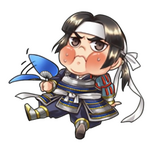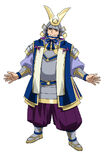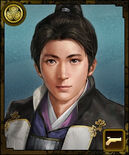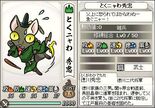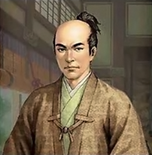| Hidetada Tokugawa | |
| Clan(s)/Alliance(s): | Tokugawa |
|---|---|
| Weapon Type: | Sword
|
| Unit Type: | Strong |
| Significant Battle(s): | |
| First Appearance: | Samurai Warriors 2 |
| Real name: | Tokugawa Hidetada
|
| Japanese name: | 徳川 秀忠
|
| Born: | May 2, 1579
|
| Died: | March 14, 1632
|
Hidetada Tokugawa is Ieyasu's third son and successor. He fought the Sanada army at Ueda Castle during the Sekigahara campaign and lost the battle horribly. He was unable to assist the Eastern army and was said to have earned his father's scorn. Still, he became the second Tokugawa shogun.
Role in Games
In Samurai Warriors 2, Hidetada appears on the Tokugawa's side at Ueda Castle, Osaka Castle and Edo Castle. In the Uesugi version of the siege of Edo Castle, Hidetada is guarding the castle in his father's absence and is in the main keep. If he is defeated before Ieyasu's arrival, his father will grieve for his son. During Musashi's story, he becomes the land's ruler but is killed by Hideyori's army at Edo Castle. With his dying breath, he pleads Hideyori to create the world their fathers wanted: a world of peace.
During Warriors Orochi 2 and 3, Hidetada serves as a substitute officer for his father.
Hidetada is Ieyasu's bumbling and seemingly incompetent son in Kessen and entitled "Hide Tokugawa". Though given large armies, he habitually loses against more intelligent and experienced opponents. Although he desires to make him proud, he is often berated by his father. In an effort to compensate for his loss at Ueda Castle, he orders for Masayuki's assassination and gravely disappoints his father. When he is named the shogun, Hidetada invokes his own desires to rule and becomes more confident in himself. He volunteers to lead the troops at Osaka Castle and, though Ieyasu is pleased with his son's eagerness, he is denied.
Voice Actors
- Alessandro Juliani - Kessen (English)
- Hiroshi Okamoto - Samurai Warriors 2~3 (Japanese)
- Keisuke Baba - Samurai Warriors 2: Empires (Japanese)
- Shōta Ebina - Sengoku Musou TV series (Japanese)
- Daisuke Sakaguchi - Kessen (Japanese)
Quotes
- "I can't let my father down! Go, attack!"
- "Father! I pledge my service to your cause! Hidetada is your humble servant, to be used as you wish, to achieve peace!"
- "Yes. One so conscientious as yourself is welcome... You will preserve the peace of future generations."
- ~~Hidetada and Ieyasu, Samurai Warriors 2: Empires
- "Lord Hidetada... Are you injured?"
- "Do-Do-Don't do that! Scared me half to death! You ninja are as desperate as the Sanada are right now. What's wrong with them anyways? They're trying their hardest to die out there. Are they dense!? Aren't you supposed to fight so you can live!?"
- "Samurai experience happiness by facing death... Their life's meaning is to perish without shame... They fight to die... It is as you have stated."
- "What's that supposed to mean? That's messed up! Do you fight with that mindset too, Hanzō?"
- "Shadows neither live nor die... They are moved only by loyalty for their masters until they are no more..."
- "Noo! I don't want for Hanzō to die! I don't wanna it, I don't wanna it, I don't wanna it! I'm, I'm so thankful that Hanzō's alive! Soooo glad! Waaah!"
- "Hmph... Master Sandayu, someone as lowly as me may be unfit to be a shinobi. But, at the end of these chaotic times, perhaps that is for the best."
- ~~Hanzō Hattori and Hidetada; 100man-nin no Sengoku Musou
- "I see the truth... my path is clear. Yes, it is. I am not my father. I am my own man with my own destiny! Why follow his path?! Hear me! I am Hidetada Tokugawa! I will protect the family my own way!"
- ~~Kessen
Historical Information
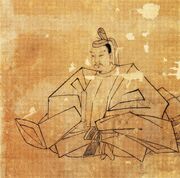
Painting from the Tokugawa Memorial Foundation.
Personal Info
Tokugawa Hidetada was Ieyasu's third son and was born at modern day Tokiwacho, Shizuoka Prefecture. His mother was Oai-no-kata, or Saigo no Tsubone, Ieyasu's first consort and thought to be Tadaharu Totsuka's daughter.
Due to a distortion of Edo period folklore, he is commonly known in fictional media as an ignorant and short-tempered man. His failure to take Ueda Castle is often portrayed as an act which earned his father's anger due to the resources he wasted trying to take it. Combined with his sheer inexperience and ineptitude, these fictional interpretations make it seem like it was a miracle that he became shogun, obtaining the title merely through birthright or underhanded scheming. He was so scared of facing his second wife, Ogō, that they hardly saw one another. To summarize the common perceptions of the first three shoguns, author Chōgorō Kaionji famously wrote, "Ieyasu did everything by himself; Hidetada fell short and did half of his decisions by himself; Iemitsu left everything to his retainers."
In reality, there is only some grain of truth from the mountain of folklore. It is true that Hidetada was not quite as resourceful as his father or brothers in war, yet he was by no means incompetent. Though often known as the "plain and unmeritorious" son, he was very dutiful and attended to his responsibilities with absolute seriousness. When it came to paperwork and official attendances, Hidetada was prudent. He reputedly never lied about his failures or his accomplishments, meaning that he was willing to accept any repercussions for his actions. The reason why he kept his distance from Ogō was to prevent a civil dispute between his consort's family and the inheritance for his son. Many Tokugawa retainers remark that he had a bold yet calm countenance whilst ruling and addressed every conflict, thus leading to his popularity amongst vassals to be Ieyasu's successor. Even when the Tokugawa forces momentarily faced the jaws of defeat at Osaka Castle, Hidetada was prepared to fight to the death if need be, willing to stand as the ill-fated rear guard to protect his father's retreat. These traits led him to shine within the political realm, and it is no mystery with historians how he could devise and establish the foundations of the Tokugawa shogunate.
His first wife was Ohime, Oda Nobukatsu's eldest daughter and one of Hideyoshi's adopted daughters. He had the most children with Ogō, who gave birth to four daughters and three sons. His short-lived eldest son, Nagamaru, was had with an unnamed family servant. His mistress, Shizuka, gave birth to his fifth son who was eventually adopted by Ogō. He also adopted several children once he became shogun to protect political alliances within the Tokugawa clan, one of whom is argued to be Komatsuhime.
When he was a child, he was either known as Nagamatsu (長松) or Nagamaru (長丸). Before he had his right to manhood ceremony, he was known as Takechiyo (竹千代). His political aliases are Edo Chunangon (江戸中納言) and Edo Udaishou (江戸右大将).
Early Life
By the time Hidetada was born, his second eldest brother (Yūki Hideyasu) was adopted –or sent as a political hostage– to the Toyotomi clan. A few months afterwards, his eldest brother (Matsudaira Nobuyasu) was ordered to commit suicide. Ieyasu was given the difficult decision of deciding his successor between Hideyasu, Nobuyasu's son, or Hidetada. He was able to rule out Hideyasu due to his ties to the Toyotomi clan. When he asked his retainers for their thoughts, only Ōkubo Tadachika supported the infant Hidetada. Through much pondering, he tentatively favored Hidetada due to his mother's family prestige within Mikawa. Most legends state that Ieyasu actually didn't reach his decision until Hidetada entered adulthood.
During this affair, Hidetada's mother passed away to her failing health so he was reared by his wet nurse, Ōuba no Tsubone. Once Ieyasu had made his choice about his future, Hidetada was raised with the intents of being his father's successor. To honor their peace treaty for Komaki-Nagakute, Ieyasu agreed to send Hidetada to be a political hostage for Hideyoshi in 1590. He received his coming of age ceremony under Hideyoshi's name, leading to the "Hide" within his given name.
During this time, it's thought that Hideyoshi wanted to groom Hidetada to be one of his possible successors. He wanted to use the twelve-year old Hidetada to bolster his ties with Nobukatsu and was used in a marriage proposal. Either Ohime's early demise or his soured ties to Nobukatsu called off the long marriage. Hideyoshi granted Hidetada a high seat within the imperial court (Chunangon) and granted him permission to use the Toyotomi name. All bets were off when Hideyori was born, which resulted in Hidetada's return to Ieyasu in 1593. Hoping to keep healthy ties between the Toyotomi and Tokugawa, Hidetada was married to Ogō in 1595.
Sekigahara
The Sekigahara campaign marked Hidetada's first personal experience with war. He was ordered to march from the east and support Ieyasu's main unit from the center route. His battalion was composed of 38,000 men and a handful of trusted Tokugawa veterans. It was agreed that the separate units were to merge together within Gifu prefecture on October 15th (September 9th in the archaic calendar).
There are two torn accounts over Hidetada's activities. The major account –which is exaggerated by Edo period folklore to harshly belittle Hidetada– states that Hidetada impetuously believed he could outdo his father by taking Ueda Castle, which was defended by Sanada Masayuki and Nobushige. Since it was an obstacle in their path, he first sent Honda Tadamasa to offer an issue of surrender to Masayuki. Once he learned his letter was rejected, Hidetada was incensed by the castle master's stubbornness and the two parties engaged in a siege. He was convinced that his larger army could overpower the tiny castle through sheer numbers, pressing the attack and ignoring the advice of his advisors to discontinue the siege. It was only after he realized that he would be late to meet with his father that he tried to retreat, suffering several ambushes laid by Masayuki along the way. This version is often heralded as sign of Hidetada's incompetence and an example of Masayuki's masterful tactics, leading to the perception that the elder is responsible for completely delaying Hidetada's march.
The other not-so-popular account –that is currently speculated by historians to be likely the historically accurate one– states that Hidetada's forces were merely following Ieyasu's orders to march through Shinano. Ieyasu had ordered his son's forces to move in advance based on his previous experiences of the area. He could not predict that they would be obstructed by heavy rainfall and seasonal over flooding, conditions which would be extremely hazardous for an army of Hidetada's size to rush. His army was ill-equipped for dealing with the downpour and were already stressing themselves to march. One of Hidetada's messengers was able to report this news to Ieyasu on October 15th. Upon learning of his son's situation, he asked his generals whether they should wait for Hidetada. Honda Tadakatsu advised waiting; Ii Naomasa pushed for an immediate attack on the Toyotomi forces. When Hidetada's forces encountered Ueda Castle soon afterwards, their situation was already strained and the siege was much shorter than Edo period folklore suggests.
When Hidetada's troops arrived five days late to the main conflict at Sekigahara, he offered his father his apologies and congratulations for being victorious. Ieyasu was "not in the mood" to face him until a day –sometimes stated as three days– later only through Sakakibara Yasumasa's mediations. It is often stated that Ieyasu was bitterly disappointed in Hidetada because of Ueda Castle, but recent historical findings suggest that his impassiveness towards his son predated this incident.
Becoming Shogun
In 1603, the imperial court granted Ieyasu the titles Minister of the Right and Seii-Taishōgun, making him one of the most powerful and influential men in the land. When he ordered the reconstruction of Edo Castle, he began to pay closer attention to Hidetada.
By May 26, Hidetada was bestowed the title General of the Right (Udaishou) by his father. The title was in very close proximity to Ieyasu's position at the time it was given (akin to the shogun title for a prince), and there was no doubt in anyone's minds that Hidetada was to be his successor. He was granted within his father's inner circle and served at his beck and whim, often filing paperwork and other inquiries sent to Ieyasu. It is often argued that there were still disputes for the right between Hideyasu and Nobuyasu's son, but these claims are difficult to verify.
Two years later on New Year's Day, Ieyasu felt comfortable entrusting the future to his son and resigned from office. He retired to Fushimi Castle to await the necessary gathering of the Tokugawa clan. Hidetada amassed several thousands of followers to attend to his trip the castle, arriving at the gate on May 2. After a week or so of negotiations and paying formal respects towards the retired shogun, Ieyasu then declared an official decree assigning Hidetada's new title and the titles for his son's inner circle. On May 26 (April 16 in the archaic calendar), when he was 27 years old, Hidetada formally became the second Tokugawa shogun.
Afterwards, Ieyasu moved to Sunpu Castle. Hidetada placed importance on ensuring that his father enjoyed a peaceful retirement by providing him with his trusted retainers. He kept the isolated system his father practiced in place, keeping the samurai caste separated from imperial influence. Around this time, Hidetada focused on renovating the family record-keeping system, ensuring that every document was properly recorded and organized. This same system was used by later generations and became a treasure trove of information for historians. He also increased religious practices for Monju Bosatsu. In August the same year, Ieyasu arranged a political marriage between Hidetada's eldest seven year old daughter, Senhime, and Hideyori. Senhime was dearly loved by both Ieyasu and Hidetada, so the order was meant to be a sign of sincerity and a hopeful measure for choking a Toyotomi rebellion.
Ordinarily, Ieyasu's retirement would have caused a dividing dyarchy. Thanks to the efforts of Tokugawa veterans, the power to lead and confirm decisions for the feudal household gradually laid in Hidetada's hands; Ieyasu accepted his weakening influence in political affairs to focus on other matters. His decisions could not be in complete effect until Hidetada approved of them. Since both parties and the retainers consented to the change, there were no civil disputes between parent and child.
Osaka Campaign
While Hidetada focused on governing and maintaining matters in the court, Ieyasu busied himself with dealing the discontent Toyotomi loyalists who remained within the west. He had gained an advantage over the weakened clan once their affluent supporter, Maeda Toshinaga, passed away in 1614. Trying to quell the western generals' complaints, he offered three compromises to the Toyotomi family for a bloodless resolution: move Hideyori to Edo, offer Yodo-dono as a hostage to the shogunate, and give up their fief and Osaka Castle. Gravely offended and outraged by the decree, the Toyotomi loyalists refused. Ieyasu heard their complaints and, realizing that further negotiations with his tight-lipped opponents would be futile, declared war on the remaining Toyotomi family by November the same year.
Hidetada was named one of the commanders for the winter assault. He marched his troops from Edo Castle, yet this time he overstressed his men for the march. When he arrived at Fushimi Castle seventeen days later, his army was tired and poorly dressed. His soldiers' armor was in tatters and much of their equipment was ruined. His hurried march is thought to either be a case of negligence or Hidetada ignoring Ieyasu's order to rest. Hidetada was unable to provide much assistance due to the beaten state of his army, earning Ieyasu's ire and annoyance. Ieyasu arguably wanted to use his son's presence to intimidate the Toyotomi forces into a peace treaty, but he had to cancel his plans and resort to attacking the enemy. Throughout the battle, Hidetada was officially put on standby.
Ieyasu and Hidetada rejoined their forces at Kyōgoku Tadataka's headquarters and used it as a step towards formalizing the momentary armistice. They were allowed easy entry into the camp since Tadataka was Hidetada's son-in-law, the husband to his fourth daughter, Hatsuhime. Ieyasu would continue to use such marital alliances to strategically maneuver his troops across the battlefield.
When peace was declared, Hidetada sought to return to Fushimi Castle. Upon learning that they would likely return to war, however, he oversaw the manufacturing of siege cannons and firearms in 1615. When he returned to Nijo Castle, Hidetada refused Tōdō Takatora's advice to immediately reunite with Ieyasu as he wished to watch Osaka Castle's surroundings and serve as a part of the vanguard. As a result, both he and Ieyasu had their own bases for the siege but were not fully coordinated with one another. He had an army of 23,000 under his command.
During the climatic battle, his troops were stationed at Okuyama-guchi. His strategist, Tachibana Muneshige, heard gunshots nearby and advised a preemptive strike on the enemy to prevent loses. Since Hidetada refused to listen to him, his base soon encountered difficulties from Ono Harufusa and company's forces. Though the camp was in distress, the situation was soon under control thanks to Muneshige, Kuroda Nagamasa, and Katō Yoshiaki's swift and brutal counterattacks. Hidetada was said to have armed himself with a spear to fight beside his men, but Honda Masanobu convinced him to think of his status and stand down. Unlike Ieyasu's forces, which suffered a short series of retreats, close calls, and hit-and-runs, Hidetada's forces were able to stand firm against the Toyotomi charge. Hidetada was unable to redeem himself from his fault from the winter campaign, but he was said to have impressed the retainers with his compassion for them. His army later assisted the siege of Osaka Castle.
After the castle's fall, Hidetada worked together with Ieyasu to decree the Laws for the Military Houses and other decrees to further separate the imperial court from the samurai caste. They would continue to do so until the year of Ieyasu's passing.
Later Years
After Hidetada ensured that his father received the proper rites for his death and afterlife, he became the main head of leadership. He immediately went to work by reorganizing military ranks by promoting Tokugawa elders and demoting or exiling any general who was suspected or guilty of misconduct, such as Fukushima Masanori and Honda Masazumi. Hidetada split territory between his vassals and younger brothers. Whilst doing so, he strengthened his position within Edo and increased his influence within the royal court by sending his fifth daughter, Kazuko, to become Emperor Go-Mizunoo's consort. By 1630, the Tokugawa were recognized to be a consort clan for the throne.
Hidetada experienced several family hardships in quick succession. In 1616, Hidetada had ordered his younger brother, Matsudaira Tadateru, into exile. The reasons why vary; either due to his rude misconduct during the Osaka campaign, his possible friendliness with Christians, or due to his fear of Tadateru's father-in-law. In the late summer of the same year, Senhime was sent to remarry Honda Tadatoki. During her wedding procession, Sakazaki Naomori –often argued to be the vassal who rescued her from the flames of Osaka Castle– planned to attack her carriage and kidnap her. Fortunately, the shogun was able to predict his assault and ordered for his execution. Alternatively, it's said that Muneshige and Yagyū Munenori intercepted Naomori before he left with the princess and convinced him to commit suicide as repentance for his crime.
His second daughter, Tamahime, died due to failing health and child birth complications in 1622. While the funeral services were still being done for her, his third daughter, Katsuhime, was nearly killed by her husband. Matsudaira Tadanao, her husband and cousin, was indignant about his father (Tadateru)'s exile and drank himself into a stupor. He lashed out to Katsuhime with his sword, and she barely escaped death thanks to two maids who were present. Hidetada punished Tadanao through exile, not allowing Katsuhime and her children to come with him.
During Ieyasu's wake in 1623, Hidetada dubbed his second eldest son, Iemitsu, his successor. Mirroring the actions of his father, he retired and gave control to his son. He decided to retire within Edo's inner keep (contemporary Tokyo Imperial Palace) and casually oversaw political affairs. He would experience tragedy again when Hatsuhime lost her battle to illness in 1630. Her husband, Tadataka, was never pleased with her company and ignored her entirely throughout their marriage. When she died, Tadataka was a spectator at a sumo match. Once Hidetada heard this, Iemitsu and him were infuriated. Hidetada forbade the Kyōgoku clan –family, vassals and servants– from attending her funeral and cut off their family ties to the shogunate.
In 1631, Hidetada's health was failing and he rarely left his bedside. Before his death in 1632, he confessed to Iemitsu his fears that his work to pacify discord between the retainers and court was still unfinished. He entrusted his son with inheriting his desire to protect their family future.
Gallery
Gallery
|
|---|
Sengoku Musou animated artwork
100man-nin no Nobunaga no Yabou portrait Tokunyawa Hidetada in Samurai Cats
Kessen screenshot |


